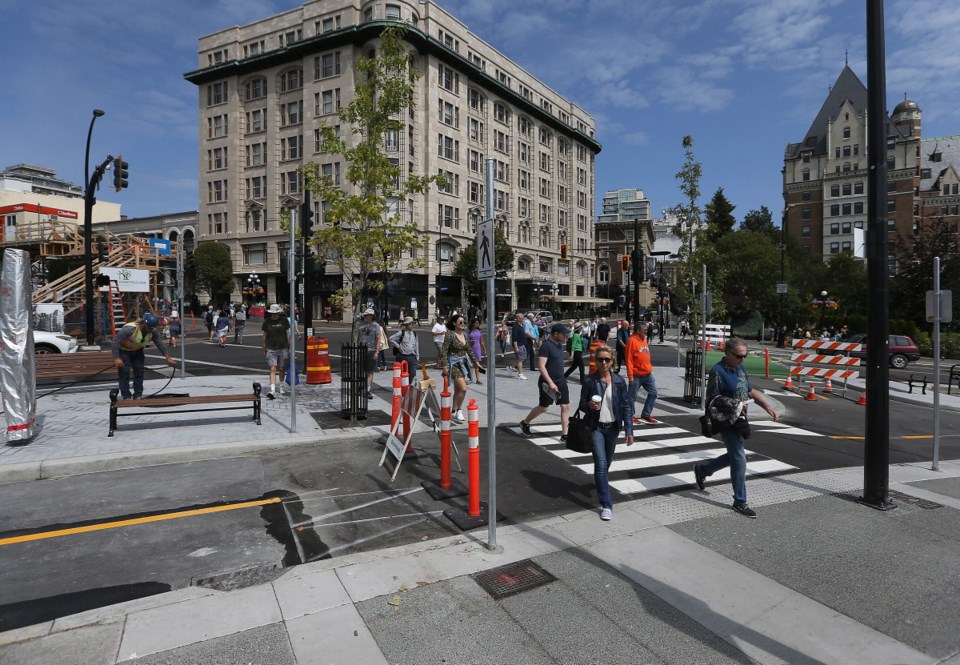A commentary by a regular cyclist on Wharf Street.
Mayor Lisa Helps and her co-conspirators in the anti-car coalition must be giddy with glee at the success of their latest project on Wharf Street.
After practice runs on Fort and Pandora, which resulted in minor inconveniences to drivers, the gong show on Wharf must feel like a grand-slam home run.
They have reduced an already sketchy stretch of traffic to an exercise in misery.
Congratulations, folks — you’ve hit the sweet spot this time.
Just a couple of little problems.
If you think you’ve given cyclists a gift, you are Wrong with a capital W.
I have been making that ride on my bicycle on a regular basis several times a week in both directions for about 15 years, and the experience has been much worse since the new lane opened.
Why?
The Times 91ԭ�� editorial on Aug. 16 pointed out one problem — the mixed messages at the exit ramp from the Inner Harbour parking lot.
That is one example of a general problem: ambiguity.
Is the green crossway at the bottom of Fort for bikes only, or pedestrians as well? I don’t know, and neither do pedestrians. But it sort of looks like a bikes-only crossing; there are no zebra markings, as there are at the bottom of Bastion Square.
And who has the right of way when pedestrians want to cross the bike lane? Should they wait until the bike traffic clears, or should the bikes come to a stop whenever pedestrians look like they’re contemplating a cross?
This is tricky, because frequently foot traffic behaves erratically or indecisively. I tend toward caution in that situation, and generally give way, but many cyclists do the opposite and treat the bike lane as a right-of-way licence.
Another significant problem is that the new system is so foreign to the established way of doing business. It is not merely non-intuitive; it is counter-intuitive. People and bikes keep turning up in unexpected places.
The separated bike lane puts cyclists where you don’t expect them to be, frequently moving in an unexpected direction. That’s a big adjustment to swallow, in an environment where small mistakes can generate bad results.
The biggest problem is that the transformation is simply too large in scope, too different from the previous system and, especially, too poorly thought out to impose on such a busy and important artery.
I’ve saved my favourite example for last: the new system gives cyclists from Wharf and cars from Pandora simultaneous access to the apron to the New Bridge. That’s right — this expensive new system merges bicycle and auto traffic onto the approach to the bridge at the same time. It’s true that car traffic from Pandora has a yield sign at the junction — but it’s also staring straight at a green light.
What could go wrong?
Once again, I offer my personal experience. After years of making this trip on a regular basis, I find myself much more at risk on the new system, supposedly designed for cyclists’ benefit. The hazards are more numerous and varied; taken together, they make the experience significantly more complicated.
By way of contrast, once I cross the bridge and continue up Esquimalt Road, order is restored, simplicity returns, and I proceed without worry with a simple white line keeping me separated from car traffic — easy for each of us to understand and follow.
Too simple, apparently, for the mayor and her henchfolk. They would rather spend several million dollars on a vastly more complicated scheme of dubious value.
Why? I suspect that its roots lie in their belief in the power of government to engineer a perfect world — despite abundant evidence to the contrary. I don’t expect my words — based on experience — to shake their certainty; they are drunk on their Kool-Aid, and uninterested in alternate flavours.
But now I have degenerated into cheap psychological profiling which, while fun, is of little value. Anyone can churn it out.
I do, however, have two suggestions that I hope will find some support.
I propose that the mess on Wharf Street become known as Lisa’s Folly. Not original, I confess, but right on the money.
And I suggest that the citizens of 91ԭ�� Street start thinking about some form of resistance to the newly approved conversion of their neighbourhood into a replica of the Folly. Malign forces are gathering around your community.
Do not go gentle.



